Eriogonum fasciculatum var. flavoviride
Bull. Torrey Bot. Club 49: 350. 1923.
Shrubs or subshrubs, rounded and somewhat compact, 2–5 × 3–6 (–10) dm, thinly floccose or glabrous, yellowish green. Aerial flowering-stems usually glabrous. Leaf-blades linear or linear-oblanceolate, 0.6–1 × 0.05–0.2 cm, thinly tomentose to subglabrous and light green abaxially, subglabrous or glabrous and green adaxially, margins tightly revolute. Inflorescences mostly capitate; branches glabrous. Involucres turbinate-campanulate, 2–3 × 2–3 mm, glabrous or subglabrous. Perianths glabrous or infrequently thinly pubescent. 2n = 40.
Phenology: Flowering year-round.
Habitat: Sandy to gravelly flats and slopes, saltbush and creosote bush communities, pinyon-juniper woodlands
Elevation: 50-1300 m
Distribution

Calif., Mexico (Baja California), Mexico (Sonora)
Discussion
Variety flavoviride is a widespread, infrequent to common, warm-desert shrub found on the Mojave and Sonoran deserts in southern San Bernardino, Riverside and San Diego counties. The yellowish-green hue of the flowering stems, inflorescence branches, and leaves readily distinguish it from var. polifolium, with which it occasionally occurs (especially in Mexico), although this feature is not always obvious on herbarium specimens. Variety flavoviride is much more attractive in the garden than its more frequently planted Mojave Desert counterpart. Reports (e.g., R. S. Felger 2000) of var. fasciculatum along the coast in extreme northwestern Sonora are based on specimens of var. flavoviride.
Selected References
None.
Lower Taxa
"dm" is not declared as a valid unit of measurement for this property."dm" is not declared as a valid unit of measurement for this property."dm" is not declared as a valid unit of measurement for this property."dm" is not declared as a valid unit of measurement for this property.